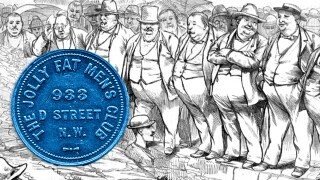The Exclusive World of 19th-Century Upper-Class ‘Fat Men’s Clubs’

Many of us will never believe, let alone admit it, but the messages we get from society have at least as much to do with what gets our boners popping as the individual preferences of said boners. What’s considered beautiful is often just what’s considered rare, and for most of human history, it was impossible for most people to be overweight because they were in a constant state of near-starvation and working themselves to death. After capitalism was invented, only the most successful and privileged could afford to eat a lot and not get up very much, so a dump-truck ass was as much a symbol of status and wealth as funny hats and a stable of horses to carry your dump-truck ass around. If you’re packing a few more pounds than you’d like, take heart: Your ancestors would be so proud.
After the Industrial Revolution, though, that started to change, and mostly not for any high-minded health reason. It had a lot more to do with the fact that most of the working class was standing relatively still in factories rather than laboring in fields, that food had become cheaper and more accessible and that more of that food was rich and processed. Basically, the peasants started looking like the upper classes, and the upper classes weren’t having it. Fortunately, their wealth afforded them the time to spend on the Victorian versions of spin classes and kale smoothies, so within a shockingly brief period of time, the standards were reversed. It wasn’t an isolated incident — the same is largely true for being pale versus tan, at least among white people, who were the only ones who counted in Western society at the time.
In between, the last gasp of high-society fatness was the “fat men’s club.” For the last couple of decades of the 19th century and the first of the 20th, all across America — and with few exceptions and even fewer surprises, it was a uniquely American tradition — fat men planned and attended events for the purpose of celebrating their fatness. They were basically supper clubs, but the suppers were huge and so were the supperers. Participation was contingent on a weigh-in at every event that was as competitive as The Biggest Loser, with some members stuffing their pockets with coins or themselves with food in a bid to meet the requirement, usually at least 200 pounds.
Don't Miss
One club actually assigned roles based on weight, with the fattest appointed president, because the “symbol” part of “status symbol” was just too, well, symbolic. There was also a refreshing amount of physical competition. The New England Fat Men’s Club held an “Olympics-style competition showcasing strength and virility,” others played baseball games, and there was even a Brooklyn Fat Men’s Bicycle Club. It sounds fun as hell and like something we should maybe start up again.
Except it was also seriously fraught with class politics. Among the members of fat men’s clubs were some of the most prominent community leaders, including doctors, lawyers, clergymen, local government officials and a few presidential candidates. (An entire president — William Howard Taft, obviously — once attended a fat men’s club meeting, though he understandably couldn’t commit to membership; he kinda had a lot going on.) It was like the Ivy League or a country club today — as much of a networking opportunity as anything else. One of the primary perks of admission was access to some of the most powerful men in the country. No wonder dudes were gaming the weigh-in. To that end, all of this was obviously extremely gendered, as was the general attitude toward fatness at the time. There were fat women’s clubs, but they weren’t nearly as popular and less fun, since fat women were a lot more stigmatized than fat men. It’s unclear what if any racial policies the clubs enforced, but it’s safe to say they were as white as a tub of mashed potatoes.
For better or worse, by the 1920s, fat had gone the way of top hats and monocles. It was supposedly because health officials had started noticing a correlation between heaviness and early death, though it’s unclear how all those sickly peasants being introduced to the category might have corrupted the data, and we still don’t really know why being fat seems to be bad for you. It’s probably more likely to be those dirty peasants that started showing up, but whatever the case, fat men’s clubs were dead. At the last meeting of the New England Fat Men’s Club in 1924, their membership had dwindled from 10,000 to only 38, and none of them passed the weigh-in, so they just disbanded.
Still, nothing can stop you from forming your own Fat Person’s Bicycle Club. There are plural Queen songs giving you permission, so be the change you want to see in the world.